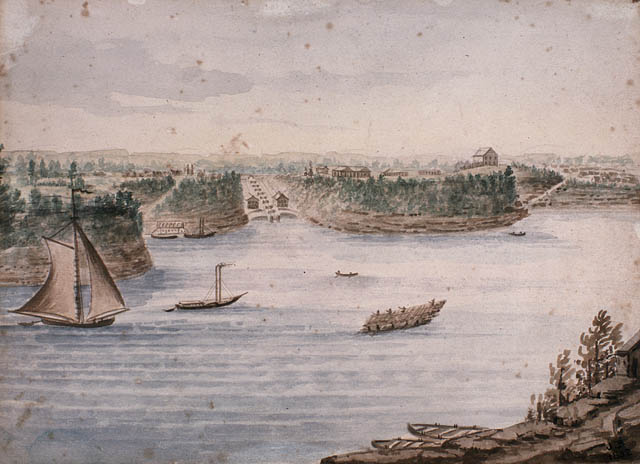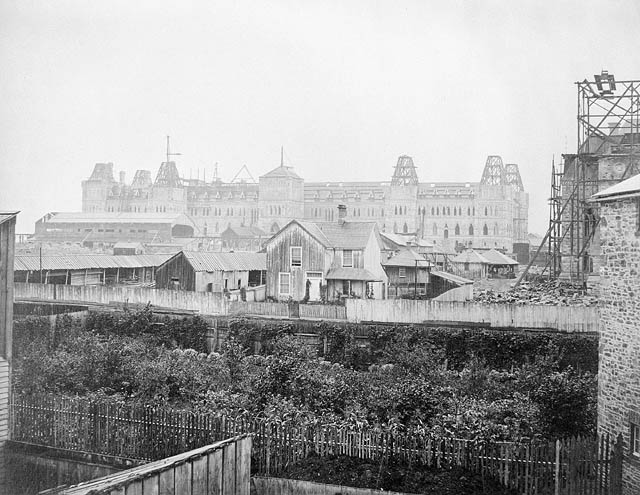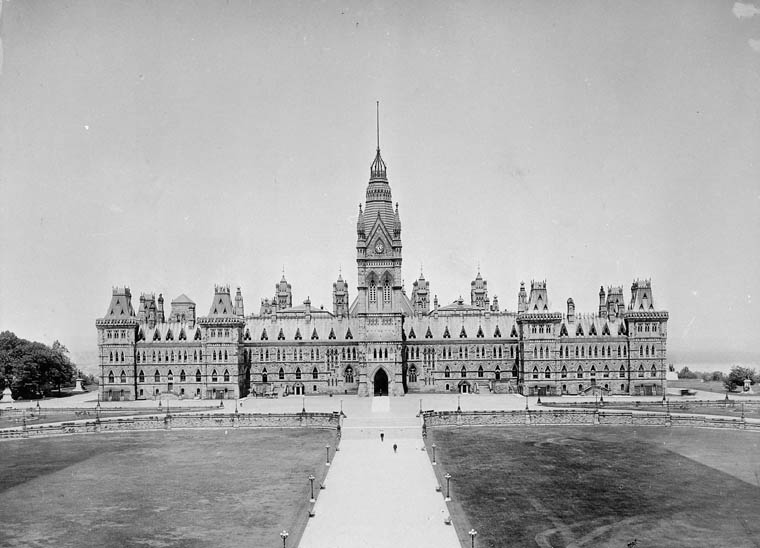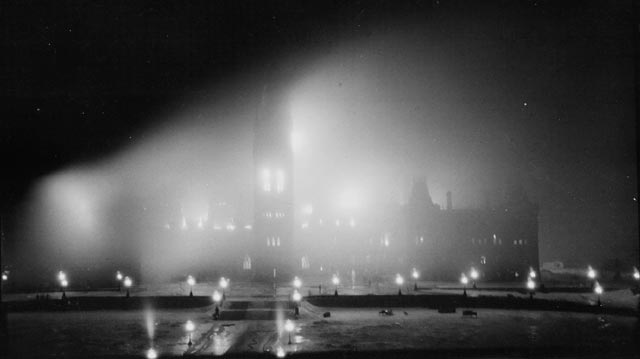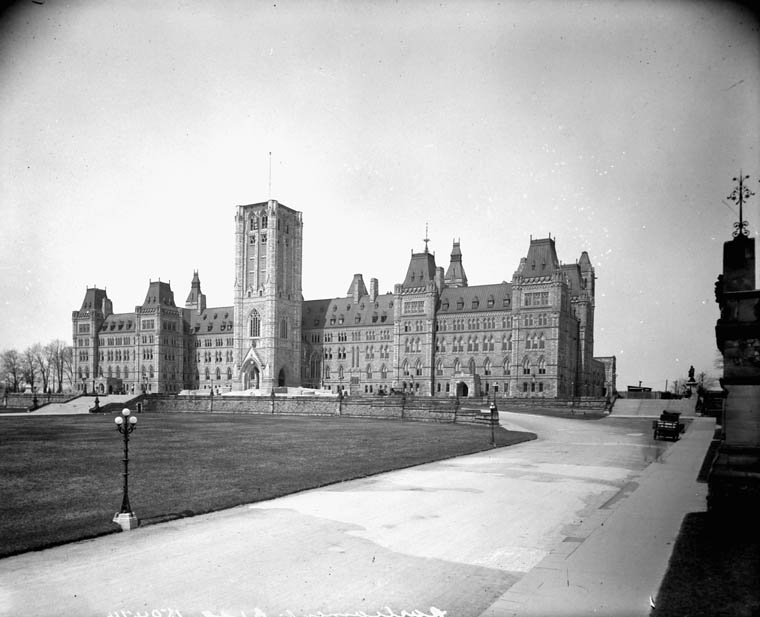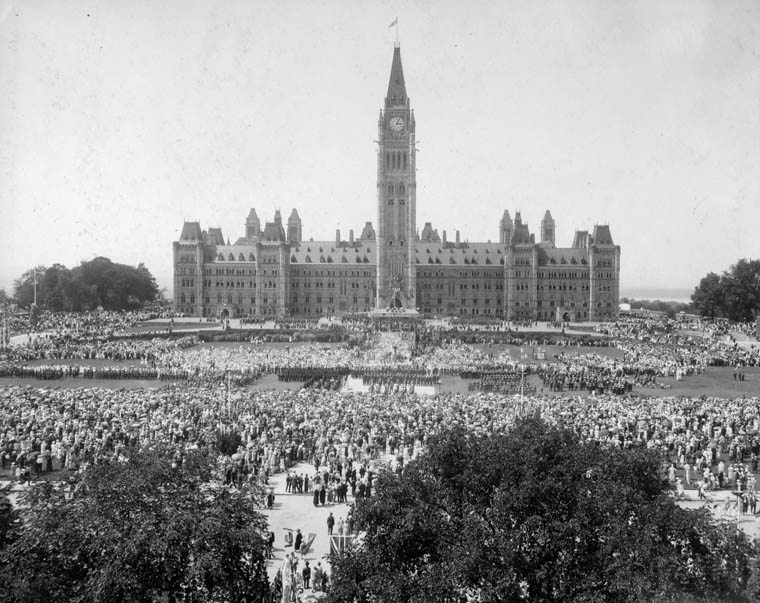History of the Hill
Learn about the events that transformed a solitary limestone cliff in the centre of a small logging town into a buzzing national capital landmark.
Timeline
- Pre-construction, 1826–1858
- Construction and expansion, 1859–1916
- The Fire of 1916
- Reconstruction, 1916–1920
- Parliament through the 20th century, 1921–2001
- Rehabilitation, 2002–present
Pre-construction, 1826–1858
- In 1826, Lieutenant-Colonel John By of the Royal Engineers begins to design and build the Rideau Canal. This navigable waterway will connect the Ottawa River in the north with Lake Ontario in the south. It will provide a secure shipping route between Montréal, Quebec, and Kingston, Ontario. The northern post of the canal is named Bytown.
- On January 1, 1855, Bytown officially incorporates as a city and renamed Ottawa. With a population of almost 7,800, the city borders English and French Canada. Just 14 years earlier, Upper and Lower Canada joined to become the United Province of Canada.
- On December 31, 1857, Queen Victoria is asked to select a location for the permanent capital of the United Province of Canada. At the time, the capital alternated between Toronto and Québec every four years. The Queen selects Ottawa because it sits far from the American border and it is situated on a cliff, making it easier to defend from a possible attack.
- On February 17, 1858, Ottawa is officially declared the capital of the United Province of Canada. The new, permanent legislature would be built on 25 acres of land atop a gently sloping limestone cliff. The "Hill," as it would be called, sits in the centre of town and overlooks the majestic Ottawa River. The new Parliament Buildings would include two legislative chambers and 170 offices. It would also house a picture gallery, library, 85 committee rooms, reading rooms, clerks' rooms and an apartment for the Speaker. All told, the space would total around 10,200 square metres.
- On May 7, 1859, the federal Department of Public Works organizes a competition for architects to submit their designs for the Centre Block, the Governor's residence and two departmental buildings. These two buildings, the East and West blocks, would form the new Parliament Buildings. In all, 298 proposals are submitted.
- August 29, 1859, the winning designs are announced. Thomas Fuller and Chilion Jones take top prize for the Centre Block. Thomas Stent and Augustus Laver take top prize for the East and West Blocks.
Construction and expansion, 1859–1916
- On December 20, 1859, ground is broken for the new Parliament Buildings. The first stones—local Nepean sandstone—are laid in the spring of the following year. Red sandstone and Ohio freestone as well as grey and green slates for the roofs will be used.
- On September 1, 1860, Edward VII, then Prince of Wales, arrives in Ottawa amid pomp and ceremony to lay the cornerstone of the new legislature. The cornerstone is made of white marble and inscribed with the names of the designers and dignitaries.
- In early 1861, Public Works reports that the project has cost two-and-a-half times more than was planned and the project is stopped in September. In June 1862, a commission of inquiry investigates the project's management problems. Construction resumes the following year.
- On July 1, 1867, the Dominion of Canada is born. Not yet complete, the Parliament Buildings in Ottawa will become the seat of government for the four provinces: Ontario, Quebec, New Brunswick and Nova Scotia. Parliament's first session opens November 6, 1867.
- In 1870, Manitoba, the North West Territories (now Alberta, Saskatchewan, Yukon, Northwest Territories and Nunavut), British Columbia and Prince Edward Island are added to Canada. The Parliament Buildings, once thought too large for such a sparsely populated country, are suddenly considered too small. To meet the growing needs of parliament, the Langevin Block was built on Wellington Street, across from Parliament Hill. It would become the first departmental office built off the Hill.
- In 1876, the Library of Parliament and the landscaped grounds are completed. Later this year, the iron Queen's Gates will be erected at the main entrance of Parliament Hill. In the less than 20 years since construction began, the buildings on Parliament Hill are complete. The buildings would represent one of the finest examples of Gothic Revival architecture in the British Empire.
- In 1905, Saskatchewan and Alberta enter Confederation. From 1906 to 1914, additions are made to all three buildings on Parliament Hill. The Royal Canadian Mint, the Public Archives and the National Museum are moved into new buildings off the Hill. The influence of Parliament Hill had begun to transform the character of the young capital.
The Fire of 1916
- At 8:37 p.m. on February 3, 1916, while the House of Commons is sitting, a fire starts in the Centre Block of the Parliament Buildings.
- A gentleman in the Reading Room notices something burning and calls it to the attention of a clerk, but it is already too late. Within minutes, the fire spreads to the corridors.
- Most are able to flee the building, through the heavy smoke, by crawling or forming human chains. As the fire intensifies, parts of the building start to collapse.
- Shortly after midnight, the Centre Block's Victoria Tower Bell crashes to the ground. A strong wind spreads the fire towards the senate.
- The fire department works through the night to control the blaze.
- Prime Minister Robert Borden and his cabinet, having escaped the fire, meet at the Chateau Laurier to make plans in haste. A temporary legislature has to be selected until the Centre Block can be rebuilt. There is a war on and the country needs to know that its leaders are moving forward.
- The next morning, the scene is bleak: broken furniture is piled high. Still burning, the Centre Block lays in ruins, caked with ice. The Library survives because of the foresight of librarian Alpheus Todd and clerk "Connie" MacCormac. Todd had insisted to the architect on iron fire doors, and MacCormac ordered the doors to be slammed shut before evacuating. In all, however, the fire claims seven lives.
- The newly completed Victoria Memorial Museum (current home of the Canadian Museum of Nature) is chosen as the temporary parliament building.
Reconstruction, 1916–1920
- On September 1, 1916, Prince Arthur, Duke of Connaught, laid the cornerstone the original cornerstone salvaged from the ruins. In doing so, he followed in the footsteps of his grandfather, the Prince of Wales, who had laid the cornerstone of the original Centre Block, A team of architects produced a design that, while similar to the original, used newly developed structural techniques and materials. The new Centre Block would also be larger and a full storey higher than the original building. To avoid another tragedy, instead of wood, interior walls are built with limestone and floors with marble. As well, corridors are more clearly laid out with easier access to the exits. The exterior frame is made of steel and covered with the same Nepean sandstone that was used in the original buildings. Because of the war, materials and labour were in short supply and expensive, slowing construction.
- On February 6, 1920, just four years after the fire, the new but unfinished building opens with great ceremony. Canada had returned from the war, its casualties numerous, but with the immense pride that follows victory. As well, Canadian soldiers earned the respect of their much larger allies, and the nation took a place on the world stage as a participant in the treaty negotiations at Versailles. The new building was a powerful symbol in our young nation's history and a beacon of our collective optimism for the post-war age.
Parliament through the 20th century, 1921–2001
- On July 1, 1927, the 60th anniversary of Confederation and the Diamond Jubilee, Governor General Viscount Willingdon dedicates the new Peace Tower. He also inaugurates the carillon, whose bells play for the first time. Prime Minister William Lyon Mackenzie King previously decided that the Peace Tower would be a fitting monument to Canada's war dead. In his speech on that day, King broadcasts a moving and powerful commitment to peace across Canada.
- In 1952, an electrical short in the roof of the Library causes a fire. The fire nearly destroys the Library and, with it, the memories and the archives of a young nation. Firefighters desperately try to reach the flames by cutting through the metal roof of the dome and pouring water through. Although the fire was extinguished, the Library's interior and many of its collections were doused with water. The incident sparks a discussion about building a larger, more efficient library on the Hill. Public Works even produces new drawings. However, none of the designs are deemed worthy and the existing library is rehabilitated. A new National Library building (now the home of Library and Archives Canada) is built a few years later, west of the Hill, to relieve some of the pressure of the old library.
- In 1955, the Old Supreme Court building, built in 1889 and looking every bit as old, is demolished. The quest for more office space on the Hill continues. In 1961, there is serious discussion to replace both the East and West Blocks with modern office buildings. By the middle of the 20th century, modernist architecture—plain and functional—is becoming increasingly popular. The public was now considering the pre-war designs of the existing buildings as outdated. However, none of these demolition projects is carried out. Instead, the interior of the West Block is renovated with modern offices to replace the old Victorian rooms.
- In 1976, the public grounds of the Parliament buildings are designated as a national historic site.
Rehabilitation, 2002–present
- In 2002, a major program to rehabilitate the Parliamentary Precinct begins. Follow the rehabilitation of the parliamentary buildings.
More information
- Learn more about Parliament's art, architecture and heritage on the Parliament of Canada's website
